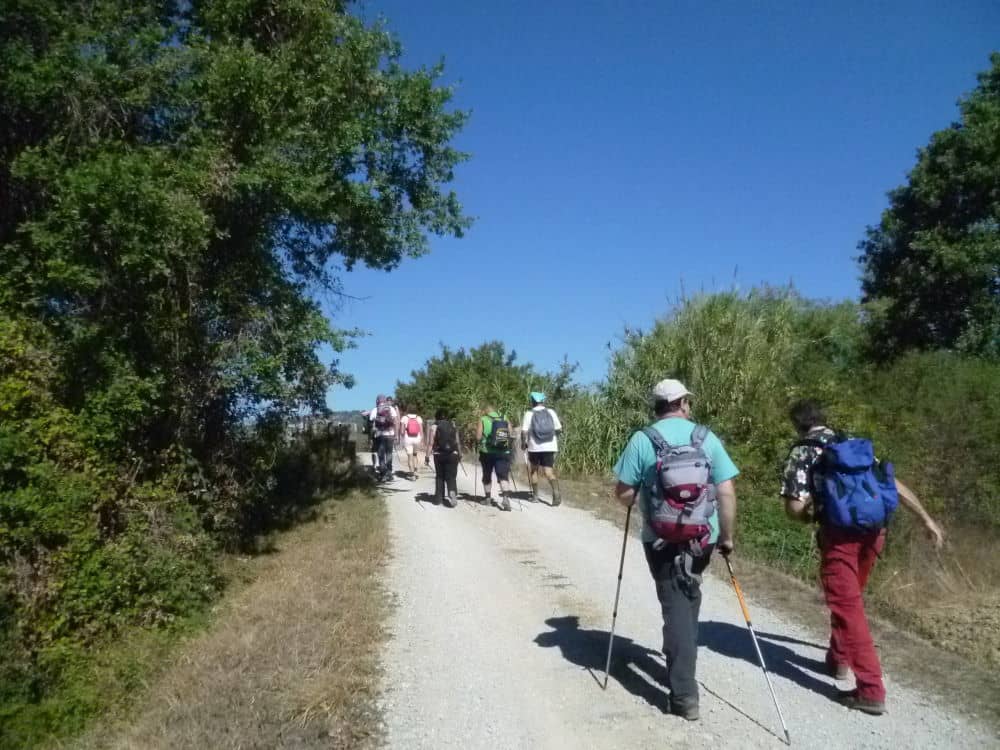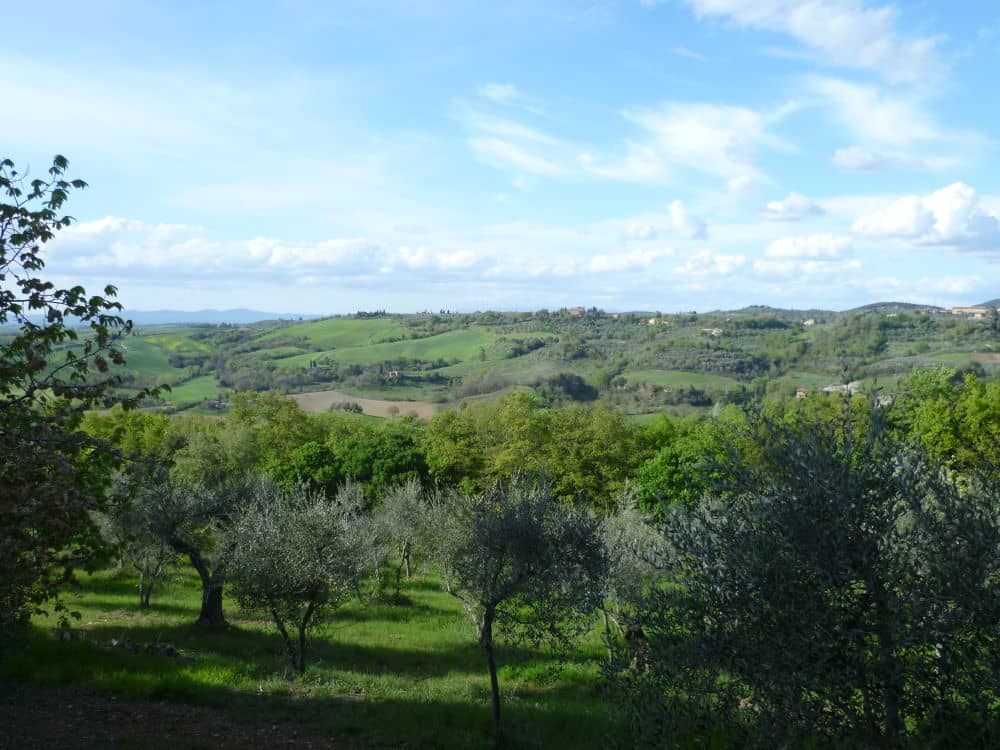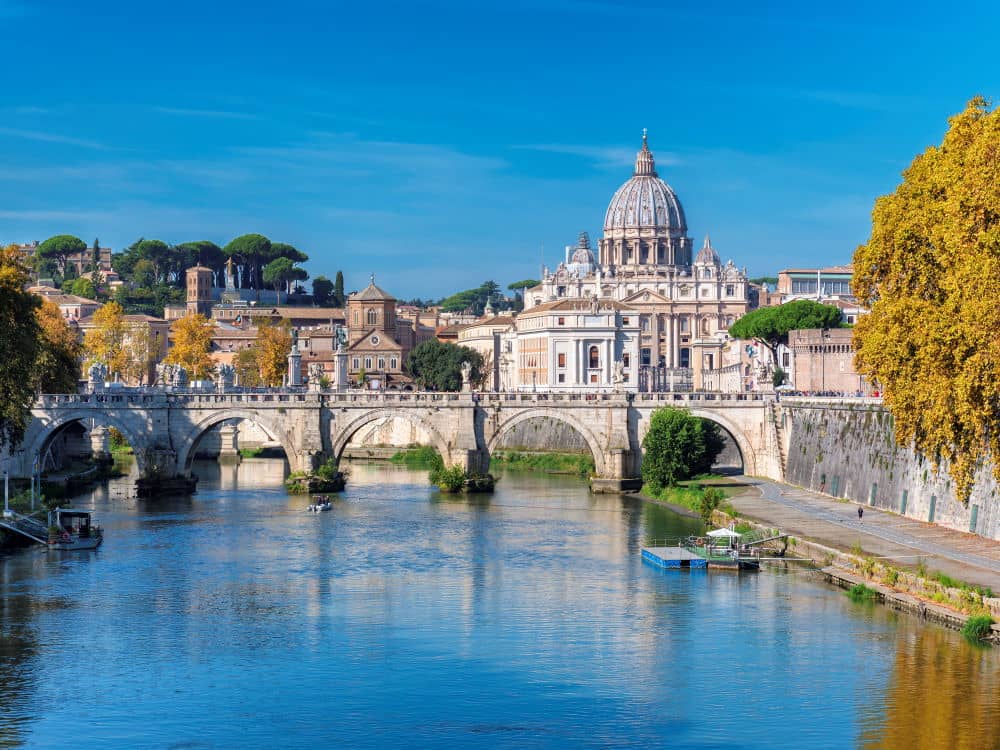Prices
Walking in Tuscany & Lazio along the Via Francigena
Lucca-San Miniato-San Gimignano-Siena-Buonconvento-San Quirico d’Orcia -Bolsena-Viterbo-Sutri-Rome
The Via Francigena was an ancient way of connection with the Alps, namely France. In fact, pilgrims came from France from the Via Tolosana, leading to Santiago de Compostela, and from Northern Europe. They crossed the Alps through Monginevro, Moncenisio and the Great St. Bernard Pass, went down to the Po Valley, and then crossed the Apennines (in Parma). From Monte Bardone pass, they arrived in Tuscany. After mayor centres like Lucca, San Gimignano, Siena, Bolsena, Viterbo, they came to the final destination of their pilgrimage: Rome. Today, the Via Francigena includes different trails, which have changed over the centuries. As the number of pilgrims traveling to Rome increased, abbeys, monasteries, churches, cathedrals and religious shrines were built in places where important relics were kept and where miracles or apparitions had happened. This amazing journey, a more leisure version of the Francigena stages Luca-Siena-Viterbo, starts in Lucca and ends in Viterbo or Rome. It is a journey on foot through an unspoilt and panoramic landscape of Tuscany and Lazio, a walk along cultural interesting towns and places like LUCCA, San Gimignano, Val d’Orcia, Siena, Lake Bolsena and Viterbo… of course you can decide to continue the Via Francigena till Rome
The Via di Roma was formerly known as Iter Francorum, later Via Francigena. It was described for the first time in the Actum Clusio, a parchment preserved in the Abbey of San Salvatore on Mount Amiata in 876. At the end of the 10th century, Sigeric, the Bishop of Canterbury, walked the Via Francigena up to Rome to be blessed by the Pope. Sigeric is the first pilgrim we have evidence of and we have several documents witnessing this: when he got back to Canterbury, he wrote a diary, where he described the whole route with several stretches and stops; later the idea of the Via Francigena as an itinerary from Canterbury to Rome has developed.
Sigeric’s document is the basis for today’s route Via Francigena.
With the proclamation of the Holy Year in 1300, the Via Francigena started to be walked by thousands of pilgrims and wanderers. In the 17th century, the way was not so popular anymore if compared to the St. James Way, which has always been very popular and today it is still a very important pilgrimage route on foot, by bike or on horseback.
Today, the official Via Francigena goes faithfully along the steps of Sigeric; however, in the past, pilgrims came from all over Europe, from different directions; many came from Spain, Switzerland, the Netherlands, France and of course from England. Many crossed the border from different passes, such as the St. Bernard pass or the Monginevro, and then they walked through Ventimiglia and Genoa following a trail along the coast. Some of them came from the sea to the harbour of Luni, south of Sarzana, near the Cinque Terre and the Tuscan coast.
In 1994 the Via Francigena – just like the St. James Way, which attracts over 200,000 pilgrims, walkers and cyclists a year, was declared as a Cultural European Path by the European Council.
Unlike the St. James Way, the Via Francigena is starting now to be discovered: it is the least travelled pilgrimage route; however, the number of pilgrims is gradually increasing.
The original Via Francigena follows mostly ancient Roman Routes: the Aurelia and the Cassia, which are now busy roads and highways. Where necessary, there are alternative routes or paths (or quiet secondary roads, when other alternatives are not possible) and even parts of the ancient Via Francigena (before Sigeric), including centres of historic and artistic interest along the way.
The daily program of Lucca-Siena (10 days)
Lucca is a charming small town with characteristic small alleys and cozy squares. It is worthwhile to visit, because there are interesting monuments like the Cathedral, de basilica San Frediano, de Torre Guinigi en de Torre dell’Orologio. It is fun to make a walk along the good preserved town walls or just sit on the Piazza dell’Anfiteatro with its small restaurants and terraces
As a start, a not too difficult walk with little difference in level along monuments of the city of Lucca. In Altopascio, an ‘ospedale’ for pilgrims was established in the 11th century to provide support to the many pilgrims. The brotherhood of the Cavalieri del Tau managed it. In Altopascio there are many churches and the Badia di San Pietro to see.
Distance: 18,5 km / 11,5 mi
Walking time: about 6 hours
Ascent/Descent: +15 m. -15 m.
Today a nature walk on part of the old original cobbled pilgrimage route. The area used to be a swamp. The route ends in Fucecchio, which has a nice old center and lies along the river Arno.
Distance: 18,2 km / 11,3 mi
Walking time: about 6 hours
Ascent/Descent: +115 m. -100 m
San Miniato, named after the martyr Miniato, is a delightful village perched on a hill a short distance from the Arno. The town is famous for its delicious white truffle, which is found in the surroundings. San Miniato is one of the stops marked by Sigerico on his return journey to Canterbury and therefore is became one of the historic stations of the Via Francigena.
The castle was built in 962 by Emperor Otto I. The tower of San Miniato became the symbol of the village. The Cathedral dates back to 1200. The façade is rather unique with a series of ceramic disks that reproduce the arrangement of the stars in the constellations of Ursa Major and Minor. Nice to visit is also the Convent of San Francesco which, according to tradition, was donated by the nobles of San Miniato to the Saint of Assisi in person, while staying in the nearby Abbey of Santa Gonda.
Distance: 14 km / 8,7 mi
Walking time: about 4 hours
Ascent/Descent: +140 m. -15 m.
Today a longer walk with more differences in level. A quiet asphalt road takes you out of San Miniato and after an hour it is abandoned and a beautiful route begins through the hills of the Val d’Elsa to Gambassi Terme, which, as the name implies, is known for its thermal baths.
Distance: 24 km / 14,9 mi
Walking time: about 8 hours
Ascent/Descent: +415 m. -239 m
San Gimignano, the town of the towers and declared by UNESCO to be part of the World’s Architectural Heritage, you see already from afar. Originally, it had 72 towers of which today 14 remained. San Gimignano is a pretty medieval walled city. The Porta San Giovanni (13th century). It is one of the most beautiful ancient gates of Italy and deserves certainly a visit! The church of Sant’Agostino has frescoes of Benozzo Gozzoli.
Distance: 13,5 km / 8,4 mi
Walking time: about 4,5 hours
Ascent/Descent: +380 m. -382 m.
A beautiful route through a typical Tuscan landscape with light up and down walking in the green hills of the Colle Val d’Elsa. The town has an attractive medieval center and is known for its crystal production. The cathedral with a 16th-century organ is well worth a visit. In the many restaurants, you can taste delicious local dishes.
Distance: 14 km / 8,7 mi
Walking time: about 4 hours
Ascent/Descent: +218 m. -298 m.
Today’s final destination is Monteriggioni, a small walled place of origin a castle, which is located in a regained swamp area. It was built by Siena to defend the area. The wall is still original and has 14 towers and 2 city gates. The town, despite being very small, has many churches.
Distance: 17,3 km / 10,7 mi
Walking time: about 5,5 hours
Ascent/Descent: +103 m. -88 m
Siena of course doesn’t need an introduction! Siena is a masterpiece of art, full of treasures such as the Duomo with the Piccolomini Library decorated with frescoes by Pinturicchio, the cathedral museum ‘Museo dell’Opera del Duomo’, the ‘Museo Civico’, the ‘Palazzo Pubblico’ …and the famous Piazza del Campo. Siena is well known for the Palio, the most famous historical horse race in the world, and for its culinary tradition with delicious plates as ‘i pici’, la zuppa ribollita served on toasted bread and cakes like Panforte, Berricuocoli and Ricciarelli.
Distance: 20,6 km / 12,8 mi
Walking time: about 6,5 hours
Ascent/Descent: +307 m. -257 m.
After breakfast ends your discovery tour along the Via Francigena through Tuscany or you continue your walk toward Viterbo and maybe even Rome!
The daily program of Siena - Viterbo (12 days)
At your arrival you will find at the reception or you hotel your travel documents. If you arrive early you have time to explore Siena. There is a lot to see and you could even consider to book an extra night to dedicate to this lovely town.
Today you can choose between two routes, which are not inferior to each other in terms of beauty. The Via Francigena splits up here into two different branches. It is a walk with beautiful views of the hill of the Val d’Arbia and with a view back to Siena. Surprising local wines can be tasted in Cuna.
Distance: 15 km / 9,3 mi or 21 km / 13 mi
Walking time: about 5 hours or 6,5 hours
Ascent/Descent: + 60 m / – 200 m
Buonconvento is mentioned for the first time in 1100. Its name in Latin bonus conventus, means “happy place”. In 1313 the German emperor Henry VII died here.
It has a nice local museum, the Museo d’Arte Sacra della Val d’Arbia, which houses works by Duccio di Buoninsegna, Pietro Lorenzetti, Andrea di Bartolo, Matteo di Giovanni and other Tuscan painters. The works come from local churches.
Distance: 16 km / 10 mi or 14 km / 8,7 mi
Walking time: about 5,5 hours or 4,5 hours
Ascent/Descent: + 100 m / – 140 m
The walk of today is through the famous Valle d’Orcia, a beautiful valley surrounded by endless rolling hills covered with grain or sunflowers. This rich green valley, which encompasses the Orcia river, from which the zone derives its name, houses the vineyards of the renowned wines of Brunello and the newcomer on the market, the Val d’Orcia DOC. This region has also many high quality local products such as the “pecorino” cheese of Pienza, tasty olive oil, saffron, mushrooms and truffles. It is no wonder that UNESCO protects this territory from the provinces of Siena and Grosseto, as a World Heritage Site. End goal of today is charming village of San Quirico, which has an example of a symmetrical Italian garden, the Horti Leonini, and some nice churches to visit
Distance: 21,3 km / 13,2 mi
Walking time: about 7 hours
Ascent/Descent: + 510 m / – 250 m
A nice walk through the hills of the Val d’Orcia, a landscape with cypresses, villages and the characteristic Tuscan farmhouses.
Distance: 16 km / 10 mi
Walking time: about 5,5 hours
Ascent/Descent: +300 m. -340 m.
Today some more differences in level. It is a varied walk through open plains interspersed with olive groves and forest. Cross the riverbed of the Formone and then with a steep panoramic climb, the Borgo Radicofani is reached. The town is known for the exploits of the bandit Ghino di Tacco, whose sculpture stands in the old center.
Distance: 17 km / 10,5 mi
Walking time: about 5,5 hours
Ascent/Descent: +540 m. -130 m.
The descent from Radicofani on the old Via Cassia is very beautiful, perhaps the most beautiful of this stage of the Via Francigena. You have a fantastic view of Monte Amiata, the green hills, and looking back at the castle
Distance: 13,6 km / 8,5 mi
Walking time: about 4,5 hours
Ascent/Descent: +90 m. -510 m.
Today Acquapendente is reached with a slight climb and from afar, you can already see the Etruscan tower “Torre Julia de Jacopo”.
Acquapendente is also called the Jerusalem of Europe, because the church, in the 12th century Romanesque crypt, has the oldest copy of the Holy Sepulchre in Jerusalem.
Distance: 17,4 km / 10,8 mi
Walking time: about 6 hours
Ascent/Descent: +60 m. -420 m.
Bolsena is lying on the shores of the Volcanic lake bearing the same name. The Romans called it Lacus Volsinii, adapting the Etruscan name, Velzna, of the last Etruscan city to hold out against Rome. Bolsena has the characteristic charm of a medieval village. The Castello Monaldeschi, built between the 12th and 14th century, houses the Lake Bolsena Museum, which illustrates historical aspects of the territory of the lake.
Distance: 22,8 km / 14,1 mi
Walking time: about 7,5 hours
Ascent/Descent: +90 m. -195 m.
A walk through the hills surrounding the lake. Montefiascone offers a beautiful view over Lake Bolsena. The renaissance church has a dome by the architect Carlo Fontana from 1674. Montefiascone is located in a well-known wine region of the white wine Est! Est !! Est !!!
Distance: 17,7 km / 11 mi
Walking time: about 6 hours
Ascent/Descent: +600 m. -300 m.
Viterbo is relatively large and lively. It has an attractive medieval centre with winding streets, carefully restored after wartime bombing damage. It has a an imposing papal palace, a Museo Civico with archaeological finds, Pinacoteca, and botanical garden. The town is famous as Spa town. The thermal baths here have been used since the Etruscan and Roman times.
Distance: 18,5 km / 11,5 mi
Walking time: about 6 hours
Ascent/Descent: +90 m. -380 m.
After breakfast ends this tour Tuscany and Lazio or you continue your walk towards Rome.
The daily program of Viterbo-Rome (7 days)
Individual arrival at your in Viterbo. At the reception will be ready your travel documentation like road book with maps. You can visit the town of Viterbo, which has a an imposing papal palace, a Museo Civico with archaeological finds, Pinacoteca, and botanical garden.
Today a route through a varied landscape of farmland and forest. Vetralla is a hill town at 400m altitude at the foot of the Monti Cimini. The remarkable San Francesco church dates from the 11th century and has a beautiful crypt.
Distance: 16 km /10 mi or 17,5 km / 10,9 mi
Walking time: about 5,5 hours or 6 hours
Ascent/Descent: +220 m. -245 m
The start of the walk goes through forest. The route passes the remains of Torri d’Orlando, an old monastery along Via Francigena. In Sutri, built on an elevation of tuff. It is a city full of history and there is a lot to see: the Roman Amphitheatre, Etruscan Necropolis, the church Santa Maria Assunta, the church Madonna del Parto built in a rock and Villa Savorelli.
Distance: 23,5 km / 14,6 mi
Walking time: about 6 hours
Ascent/Descent: +250 m. – 270 m.
Today the route passes the waterfalls of Monte Gelato and through the Regional Park “Parco di Veio” where no fewer than 12 orchid species can be found. The current old center of Campagnano di Rome dates back to the 12th century, as can be seen from the Porta Romana, several medieval towers and the San Giovanni church.
Distance: 24,5 km / 15,2 mi
Walking time: about 7 hours
Ascent/Descent: +240 m. – 240 m.
Today the route passes through the heart of Lazio. It is a day of vineyards, fields and olive groves. You can take a break in the center of Formello. Here is the Palazzo Chigi, the old residence of the Orsini family, now an ostello. It is the zone of the Roma e Tarquinia DOC wines, which taste great with the local cheeses.
Distance: 22,8 km / 14,1 mi
Walking time: about 6,5 hours
Ascent/Descent: + 220 m. – 330 m.
The highlight of the walk is certainly the St. Peter’s Church in Rome. This enormous basilica with the tomb of Saint Peter was and is the goal of many pilgrims who, after overcoming all difficulties, finally knelt by his tomb.
YOU DID IT!
There is so much to see in Rome that it is worth taking extra days
Distance: 19,1 km / 11,9 mi
Walking time: about 6,5 hours
Ascent/Descent: +25 m. -170 m
After breakfast ends this tour through a unique landscapes and past know and unknow places.
Impressions of the Via Francigena
LEVEL 2,5
It is difficult to value this route. There are days which are a level two and days which are more a level 3, because of the long distance. So we valued this tour as a 2,5. The routes run through hilly areas and over plains. It is a tour for experienced walkers in good physical condition. Some days are easier because of shorter distances and flatter terrain. Daily distances go from 11 km (minimum) to 24 km (maximum). On request, on some stretches transfers can be arranged in advance to shorten the longer routes.
Total km:
Total stage 1: 140 km / 87 mi
Total stage 2: 175 km / 109 mi
Total stage 3: 106 km / 66 mi
DEPARTURES:
From April to end of October 2024 – other months upon request.
PARTICIPANTS:
2 or more people.
START / FINISH:
Lucca / Rome

The Way of Saint Francis pilgrimage walk
The ‘Way of St. Francis’ is a pilgrims route from La Verna to Rome passing all places which remind us of Saint Francis and his compagnons.





